A DMCA takedown is when you ask a
Hopefully, this won’t happen to you, but if it does, this article will help you get the offending material taken down.
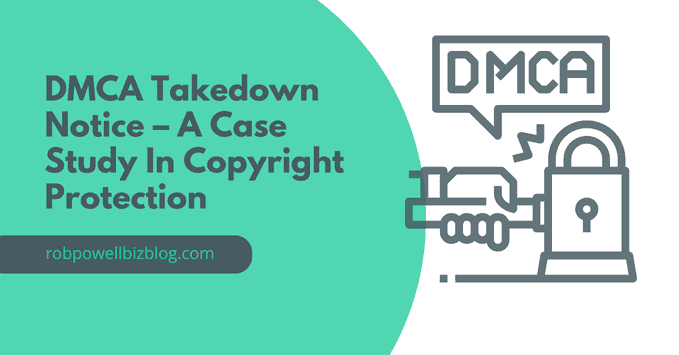
In early 2021 I discovered that an article I wrote as a guest post in 2017 was now appearing on another website under someone else’s name.
The article was not just plagiarized: it was word-for-word and image-for-image, an identical copy of my article. The only thing different about the article was that the author was now someone else.
In this article, I’ll show you the exact steps I took to have that article removed.
But before getting into the details, what is DMCA, and what rights does it give you?
The Digital Millennium Copyright Act, 1998 (DMCA)
The Digital Millennium Copyright Act, 1998 is United States copyright law that gives effect to a 1996 treaty of the World Intellectual Property Organization.
DMCA makes it illegal to produce or disseminate content, technology, devices, or services that are the copyright of someone else.
As Kinsta notes, DMCA is focused on where the content is hosted not where you are located. For example, you might be located in India, but if the offending content is hosted in the US, then your copyright is protected by DMCA. And even if your
“A DMCA takedown notice applies to where the content is physically hosted. So people outside the US can still file DMCA complaints. For content hosted outside of the US, many hosting providers will still honor DMCA complaints, however, legally they are not obliged to comply” – Kinsta
Copyright Law and Your Online Content
There are two aspects of U.S. copyright law that are relevant here:
- Under U.S. copyright law, a person automatically owns all the rights to work they create. Your copyright comes into existence the moment you create a piece of original work. When that work is “fixed” (for example, by publishing it on a website), your copyright is created: “Copyright protection in the United States exists automatically from the moment the original work of authorship is fixed” (see this guide issued by the US Copyright Office):
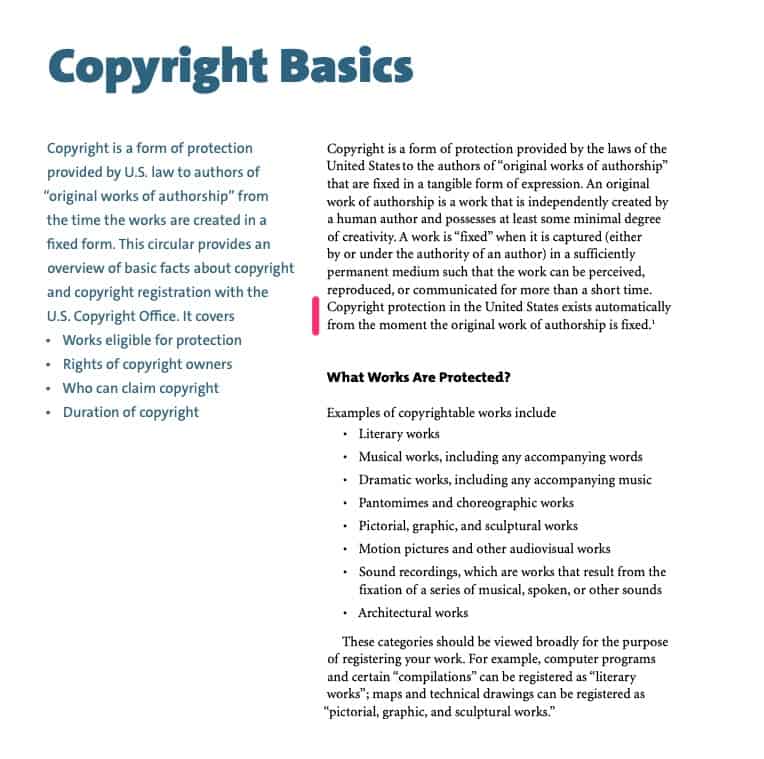
- No one else acquires any rights to that work unless you grant it to them through an explicit written agreement, as is clear from the following statement by Findlaw:
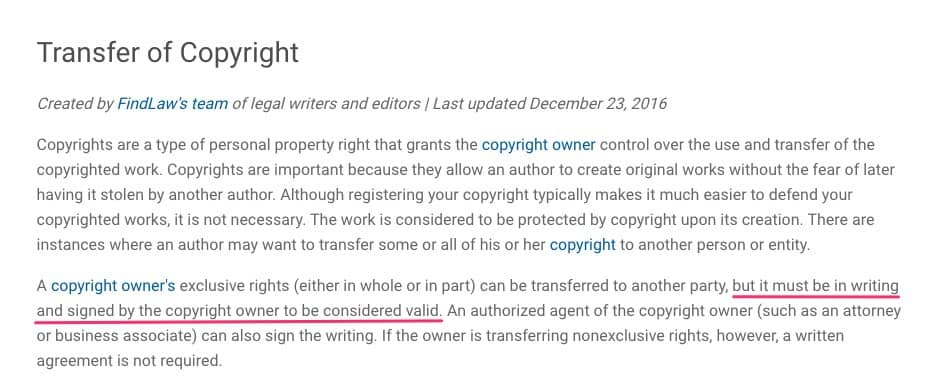
That means that if you write a guest post for another website, you still own the copyright to that article (unless you signed a written agreement transferring the copyright to the other website).
DMCA and Web Host Service Providers
Under the DMCA, Internet service providers (ISPs) such as web hosts are shielded from copyright infringement liability as long as they meet certain conditions.
The most important of these conditions are:
- The ISP must “not have actual knowledge that the material or activity is infringing” copyright
- The ISP must “upon obtaining such knowledge or awareness, act expeditiously to remove, or disable access to, the material”
In other words, as soon as a
So with that out of the way, let’s get to the nitty-gritty.
Background To The Case
In early 2017 I wrote a guest post for a well-known website in the blogging niche, which I will call ‘website A. The article did very well, attracted a lot of comments and shares, and ranked on Page #1 of Google for its keyword.
My Article Loses Its Backlink
In late 2020, the owner sold that website to someone else. I became aware of this because I noticed that my backlink from that website had dropped out.
My name still appeared as the author of the article. But the new owner of the website (whom I will call Person A) had removed the link to my website. Now, when you clicked on my name, it redirected to a web page advertising Person A’s online blogging course.
I was somewhat peeved (a) to have lost the backlink (which had been a ‘do follow’ backlink) and (b) that my name was now linking to the new owner’s sales page.
I had put a lot of work into the article, which was a guide on how to write introductions to blog posts.
As part of the research for the article, I examined the introductions used in 50 different blog posts written by well-known content marketers and bloggers. I used that research to develop a ‘typology’ of hooks or opening sentences that expert writers use to grab the reader’s attention. In short: I did a lot of original research for that article.
So naturally, I was not happy that someone else was now using the article entirely for their own purposes.
I asked him to either restore the link to my website or remove the article from his website.
But I never heard back from him.
My Article Gets a New Author
Then, a few months later I was researching something about blog post introductions, and my article appeared in the search results.
Only this time, I was no longer the author. The article was now being claimed as the work of someone else. This was not Person A, however, but someone else (who I will call Person B).
Not only that, the original URL of my article now redirected to another website, which I will call ‘website B’.
DMCA Takedown – Three Simple Steps
What follows are the steps I took to have the infringing material removed. I have divided the process into three steps:
- Assembling the evidence
- Identifying the
web host whose servers contained the infringing material - Submitting a DMCA takedown request
Step 1: Assembling the Evidence
I then assembled the evidence I needed to show that I was the author of the article.
But I had a problem that most people in this situation probably won’t have.
If you look at standard DMCA takedown notices, they all have two key requirements:
- the URL of the infringing material
- the URL of the original (authorized) version
My problem was that even the URL of the original version now had someone else as the author.
How could I prove that I was the author when there was no online version of the article with me as the author?
Well, fortunately, there was a solution.
There’s a very useful website called Way Back Machine at www.archive.org which takes ‘snapshots’ of every single web page on the internet at various times in the page’s history.
And fortunately for me, Way Back Machine had taken a snapshot of my article on 10th April 2018.
I took screenshots of that web page as it appeared on 10 April 2018 and I also saved it as a PDF.
I had one other source of evidence that I was the author of the original article.
When you write a guest post, it’s often a requirement that the author responds to any comments that readers leave on the post. And that was the case with my article.
The article had accumulated 59 comments so I had lots of automatic email notifications telling me there was a new comment that required a response.
I took screenshots of eight of these emails as further evidence that I was the author of the article.
Step 2: Identifying the Web Host
I used a free online tool called Who Hosts This to find the ISP that was hosting the new website (where my article now appeared under someone else’s name).
Step 3: Submitting the DCMA Takedown Notice
Next, I contacted the
I sent them an email that:
(a) identified the URL of the infringing material and provided evidence, and(b) provided evidence that I was the author of the original article.
The
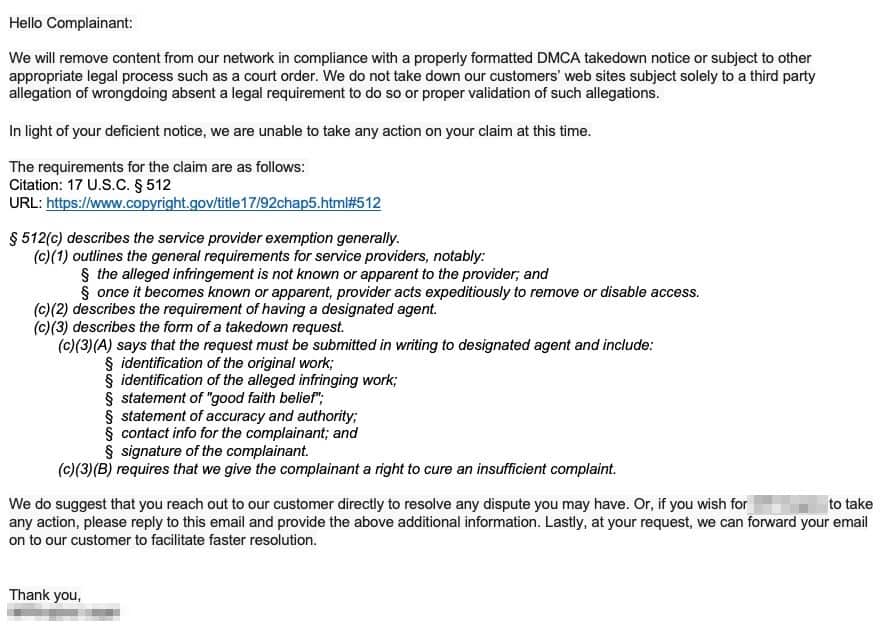
After a further exchange of emails, we established that the missing information from my DMCA notice was the items highlighted in yellow:
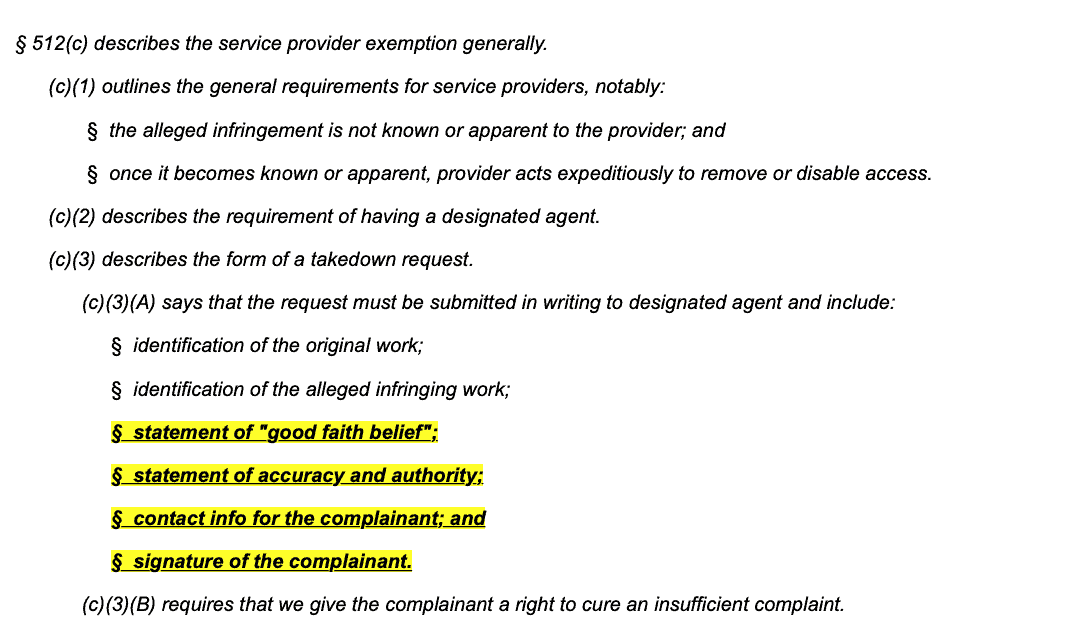
I then wrote back to the
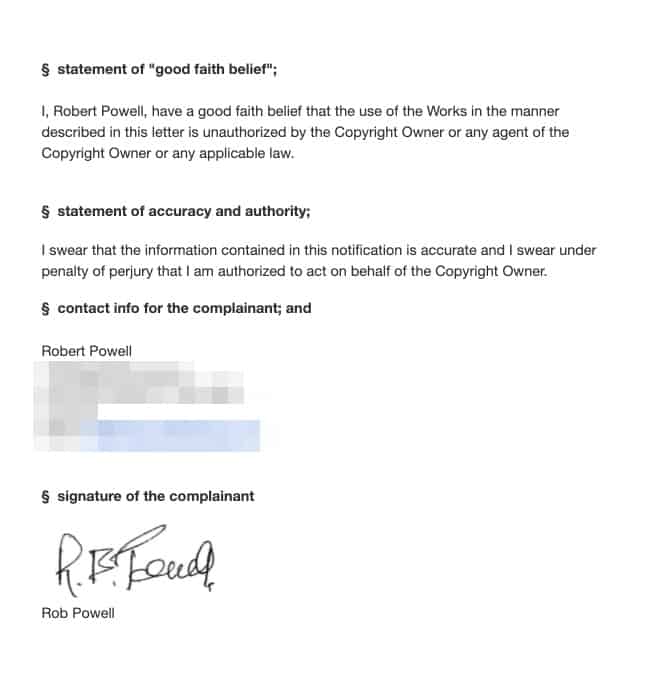
The next day, I received an email from the
I checked, and 24 hours later the ‘stolen’ version of my article had disappeared. Much to my relief, it had also disappeared from the original website (the one that redirected to the second website, where my article appeared under someone else’s name).
It had taken 5 days, from the date of my first email to the
When Does A Guest Poster Lose Copyright?
Now that I’ve covered the process I followed for removing the infringing material, I want to clarify some issues around copyright as it applies to guest posts.
The person who claimed my work as his own seemed to believe that by purchasing the website where my guest post had originally appeared, he had somehow acquired the copyright to my article.
But this is not the case, as I argue below.
A few days after the infringing material was removed from website B, I received the following email from Person B:
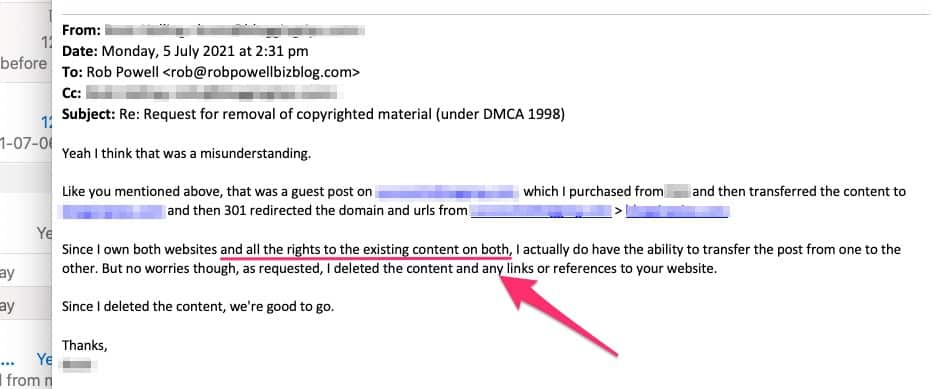
But Person B left out an important detail. He not only transferred my article to a new website, he also claimed it as his own work: he claimed to be the author of the article that I wrote.
In fairness to Person B, he may have genuinely believed that by purchasing that website, he now owned the copyright to all the material that was on that website when he purchased it.
But is this right? When you purchase a website, do you automatically acquire copyright to the content on that website? Let’s look at what US copyright law says about this.
The Findlaw article that I referred to above states the following:
Copyrights are a type of personal property right that grants the copyright owner control over the use and transfer of the copyrighted work. Copyrights are important because they allow an author to create original works without the fear of later having it stolen by another author. Although registering your copyright typically makes it much easier to defend your copyrighted works, it is not necessary. The work is considered to be protected by copyright upon its creation. There are instances where an author may want to transfer some or all of his or her copyright to another person or entity.
A copyright owner’s exclusive rights (either in whole or in part) can be transferred to another party, but it must be in writing and signed by the copyright owner to be considered valid. An authorized agent of the copyright owner (such as an attorney or business associate) can also sign the writing. If the owner is transferring nonexclusive rights, however, a written agreement is not required.
I’m not a lawyer, but my understanding from this article by Findlaw suggests that Person B didn’t acquire the copyright to my guest post. The Findlaw article clearly states that under US copyright law, no one else can acquire any rights to your work unless you grant it to them through an explicit agreement.
I never signed any such agreement, either with the original owner of the website or with the person who purchased that website. In other words, I never relinquished my copyright.
In summary, my reading of the Digital Millennium Copyright Act and the Findlaw article quoted above indicates that the author of a guest post does not lose copyright in their article unless they explicitly sign their copyright away in a written agreement. The guest poster retains their copyright, even if the website is subsequently sold to a third party.
Removing the Infringing Material From Google Search
As well as having the infringing material removed from the offending website, you may also want to remove it from Google Search.
In my case, the stolen article still appeared on Page #2 of the search results for the relevant keyword.
On desktop, the SERP snippet for the infringing article was linked to a 403 Forbidden Page error message.
So I wasn’t too worried about that: presumably, the Google algorithm would realize in due course that the page no longer existed and would remove the result from the SERPs.
But on mobile, the search result had been cached as an AMP page. That meant that even after the
There’s a form where you can ask Google to remove material that infringes your copyright from the search results.
Select the first option on this form:
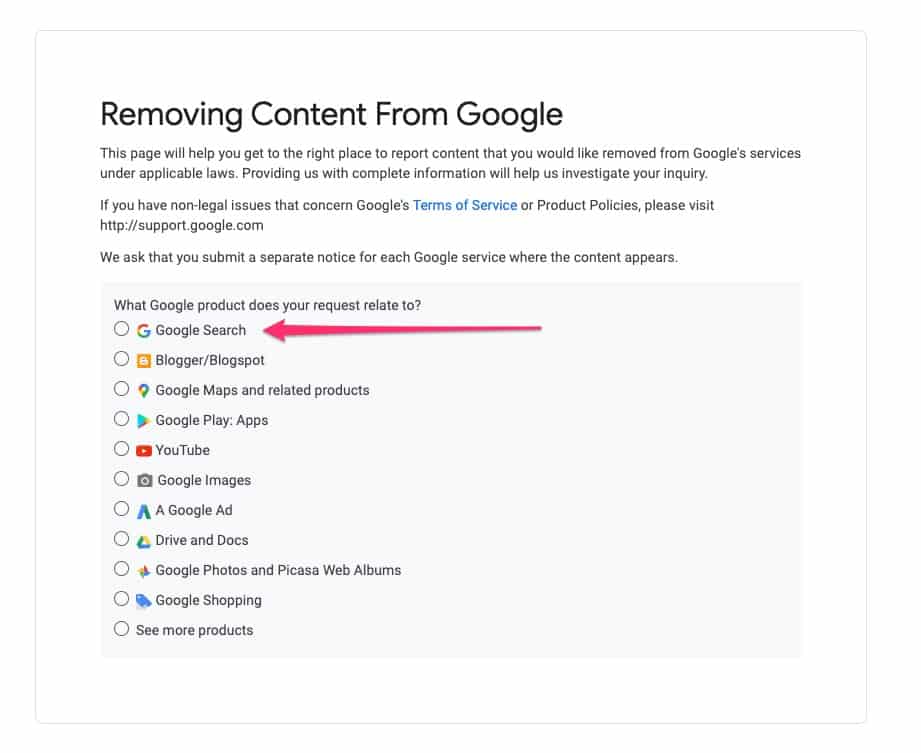
On the next page select the first option again:
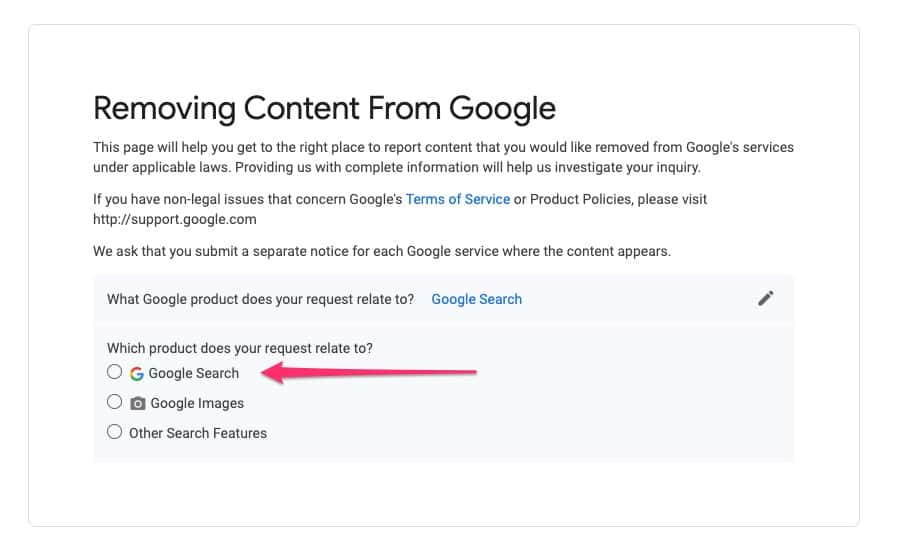
And on the next page, choose the ‘intellectual property option’:
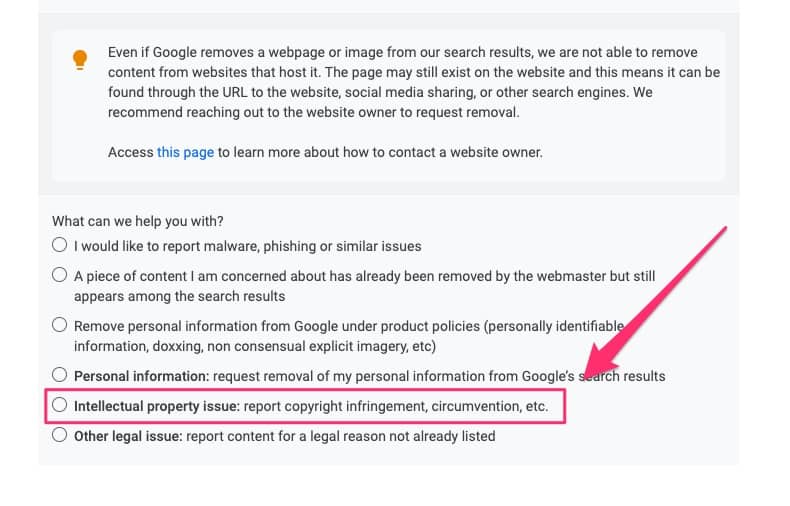
As with a standard DMCA takedown notice, the remainder of the Google form will ask you to specify (1) the URL of the infringing version of the material and (2) the URL of the authorized version of the material.
DMCA Takedown Services
With DMCA you can either do it yourself (as I did) or you can hire someone else to do it for you.
Here are two services that will handle your DMCA takedown for you
DMCA.com are specialists at having stolen content taken down using the DMCA process. This option is almost certainly cheaper than hiring a lawyer. And it has the advantage that DMCA is all they do, so they know it inside out.
Guardlex have been handling DMCA takedown cases since 2009 and have sent more than 100,000 DMCA requests. So they know a thing or two about DMCA!
DMCA Takedown Notice [Templates]
If you decide to handle the process yourself, there are two steps you need to take:
- Step 1: ask the website owner to remove the infringing material, and (if that fails)
- Step 2: ask the
web host to remove the infringing material
Here are templates that you can use for each of these two steps:
Step 1 – Ask the website owner to remove the infringing material
Here is a template you can use to ask the website owner to remove the infringing material (this should always be your first step):
Hello,
My name/company is [NAME[/COMPANY] and I discovered that your website [https://domain.com] has been using content that is owned by me. That content is infringing my copyright.
The authorised version of the content is located at this URL:
[full URL of original version of content]The unauthorised version of this content is located at this URL:
[full URL of infringing version of content]Please remove all copyrighted content belonging to [NAME/COMPANY] immediately otherwise I will have to proceed with filing a DMCA complaint.
If you have any questions regarding this, let me know.
Thanks
Step 2 – Ask the web host owner to remove the infringing material
If that fails, your next step is to send a DMCA notice to the
A DMCA takedown notice asking a
- URL of the infringing version of your article
- The URL of the original, authorized version (or evidence that it once existed in the form of screenshots, email notifications, etc)
- A statement of good faith belief
- A statement of accuracy and authority
- Contact info for the complainant (that’s you)
- Signature of the complainant
Here’s a template you can use:
Hello,
Pursuant to Section 512(c) of the Digital Millennium Copyright Act (”DMCA”), this communication serves as a statement that:
- I am [the exclusive rights holder | the authorized representative of the exclusive rights holder] for [title of copyrighted material being infringed upon] located at this URL:
- These exclusive rights are being violated by material available upon your site at the following URL:
- I have a good faith belief that the use of this material in such a fashion is not authorized by the copyright holder, the copyright holder’s agent, or the law;
- Under penalty of perjury in a United States court of law, I state that the information contained in this notification is accurate, and that I am authorized to act on the behalf of the exclusive rights holder for the material in question;
- This is my signature [attach scanned copy of your signature with printed name underneath signature]
I may be contacted by the following methods (include all): [physical address, telephone number, and email address];
I request that you remove or disable access to this material as it appears on your service without delay.
Thank you.
Regards,
[your full legal name]
Conclusion
To sum up, this is what you will need to do for a DMCA takedown of content that infringes your copyright:
Step 1: Use a
Step 2: Provide the
- The URL of the infringing version of your article
- The URL of the original, authorized version (or evidence that it once existed in the form of screenshots, email notifications, etc)
- A statement of good faith belief
- A statement of accuracy and authority
- Contact info for the complainant
- Signature of the complainant
Step 3: Use Google’s DMCA page to request removal of the infringing material from the search results.
I hope this article helps you submit a successful DMCA takedown notice.